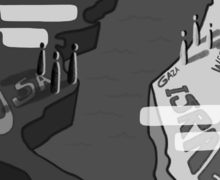SU professor talks work with Skä·noñh Center — Great Law of Peace Center
Hannah Ly | Contributing Photographer
Sandy Bigtree (left) and Philip Arnold (right) view installation at Skä·noñh — Great Law of Peace Center.
 When Sainte Marie among the Iriquois, a reproduction of a Jesuit mission in Onondaga territory, went out of business in 2012, Philip Arnold thought the land could be better memorialized.
When Sainte Marie among the Iriquois, a reproduction of a Jesuit mission in Onondaga territory, went out of business in 2012, Philip Arnold thought the land could be better memorialized.
Today, the the Skä·noñh – Great Law of Peace Center sits in the same spot as the former mission, but as a museum that tells the story and influence of the Haudenosaunee people at Onondaga Lake.
Arnold, the founding director of the center and a Syracuse University associate professor, said the foudning of the Great Law of Peace at Onondaga Lake was the more important story to tell. The Jesuits, for which the site was formerly dedicated, were in Onondaga territory for less than two years.
One of the rooms in center focuses on the influence that indigenous people have had on Western democracy in culture.

The Skä·noñh Center features the history of Native Americans from central New York. Hannah Ly | Contributing Photographer
“Skä·noñh” is an Onondaga greeting that means peace and wellness, referring specifically to the peace that comes about when humans live in harmony with the natural world. The rooms in the museum tell stories of the people.
An exhibit at the Skä·noñh Center gives an account of a messenger, known as the Peacemaker, going to Onondaga Lake to reconcile the five warring nations of the Haudenosaunee people. Bigtree said this account is still relevant today, given the state of the environment.
“This very lake where the Peacemaker came is now today the most chemically polluted lake in the Americas,” Arnold’s wife, Sandy Bigtree, said. “So, I think that story is right at the core for where we need to go as human beings to have a viable future for all of us.”
Though Arnold isn’t indigenous, his wife is of Haudenosaunee descent, and has inspired his passion for Native American heritage, along with his sons, he said.
Arnold is also a co-coordinator of the Skä·noñh Center’s academic collaborative, the Onondaga Historical Association, the Onondaga Nation, SUNY-ESF, LeMoyne College and Onondaga Community College, among others.
Bigtree is also member of the academic collaborative and has worked with the Skä·noñh Center since its inception, she said.

Sandy Bigtree is a member of the academic collaborative and has worked with the Skä·noñh Center since its inception. Hannah Ly | Contributing Photographer
Bigtree is of Mohawk heritage. Her father grew up on the Mohawk Nation territory of Akwesasne, but she grew up in Syracuse, separated from the community. She later went back and studied her personal background while doing research in preparation for the opening of the Skä·noñh Center, she said.
Their sons, Clay and Kroy Arnold said they stay in touch with their Haudenosaunee roots through lacrosse, which they’ve both played since they were three.
“(Lacrosse has) been more of a platform for me to share that the Haudenosaunee are still alive and well,” Clay said, “and the fact that we’re in a history textbook is not accurate because we’re not history. We’re still around.”
Clay said his father serves as an ambassador of the Onondaga Nation to the Syracuse University community. He’s creating a connection between the university and the heritage of Native American people, Clay added.
“He comes into work every day knowing that he gets to teach, and hopefully open up young minds about the Haudenosaunee,” Clay said, “And that the Haudenosaunee is not just a group of people that happened in the past, but they still practice their cultures and traditions today.”
Published on November 20, 2019 at 10:48 pm
Contact Mandy: ackrayna@syr.edu | @MandyKraynak





